Chapter 6 – Logical Link Control (LLC)
Chapter 6 – Logical Link Control (LLC). Logical Link Control (LLC) Logical Link Control Services. Introduction The primary purpose of this sublayer is to provide a means of transferring data across one or more MAC-controlled links LLC Services
Share Presentation
Embed Code
Link
Download Presentation
- service
- flow control
- service primitives
- connection setup
- acknowledged connectionless service
- connection mode service primitives

hayden + Follow
Download Presentation
Chapter 6 – Logical Link Control (LLC)
An Image/Link below is provided (as is) to download presentation Download Policy: Content on the Website is provided to you AS IS for your information and personal use and may not be sold / licensed / shared on other websites without getting consent from its author. Content is provided to you AS IS for your information and personal use only. Download presentation by click this link. While downloading, if for some reason you are not able to download a presentation, the publisher may have deleted the file from their server. During download, if you can't get a presentation, the file might be deleted by the publisher.
Presentation Transcript
- Chapter 6 – Logical Link Control (LLC) 635.412 Class #2
- Logical Link Control (LLC)Logical Link Control Services • Introduction • The primary purpose of this sublayer is to provide a means of transferring data across one or more MAC-controlled links • LLC Services • LLC services are provided to higher layers across LLC service access points (LSAPs) • These services are specified in terms of service primitives (aka – commands or functions) • Three forms of services are specified in the IEEE 802 standard: • Unacknowledged connectionless service • Connection-mode service • Acknowledged connectionless service Class 2: More Basics
- Logical Link Control (LLC)Logical Link Control Services • Unacknowledged Connectionless Service • Provides a datagram service with no acknowledgements, error-control, or flow control • This service type supports individual, multicast, and broadcast addressing • Only two primitives are defined: the request primitive (DL-UNITDATA-request) for upper layers to pass data to the LLC sublayer for transmission and the indication (DL-UNITDATA-indication) primitive to pass received data up to the upper layer • A priority can be specified in the primitive, but it is only passed down to the MAC sublayer for implementation Class 2: More Basics
- Logical Link Control (LLC)Logical Link Control Services • Connection-Mode Service • Creates a logical connection for data transfer (DL-CONNECT-request, indication, response, confirm). • This service type provides flow control, sequencing of data, and error indication and recovery • Like the Unacknowledged Connectionless service a priority for the connection can be specified, but it is up to the MAC sublayer to actually implement it • Four primitives defined for connection setup (CONNECT-request, indication, response, and confirm) • Example of successful connection setup • Rejection of a connection setup • Two primitives defined for data transfer (DATA-request & indication) • No acknowledgements are given to each data frame; delivery is ‘guaranteed’ (errors are indicated by a reset or disconnect) Class 2: More Basics
- Logical Link Control (LLC)Logical Link Control Services • Connection-Mode Service (continued) • Two primitives defined for connection teardown (DISCONNEC-request & indication) • Four primitives defined to reset the data flow (RESE-request, indication, response, confirm) or allow error recovery to occur. • Two primitives defined for flow control (CONNECTION-FLOWCONTROL- request, indication, response, & confirm) which can limit the amount of data passed across the LSAP • Examples of Connection-Mode service primitives: Class 2: More Basics
- Logical Link Control (LLC)Logical Link Control Services Class 2: More Basics
- Logical Link Control (LLC)Logical Link Control Services • Acknowledged Connectionless Service • Defines a service where successfully transferred data is acknowledged without the latency & overhead of connection management • Actually includes two related but independent services: a guaranteed delivery service (DL-DATA-ACK-request, indication, status) and a poll (DL-REPLY-request, indication, status-indication) with a guaranteed response • Guaranteed delivery service has three defined primitives • Two (request & indication) for data transmission & delivery • The final primitive (status indication) provides the acknowledgement • The service class parameter is really only useful with the 802.4 MAC specification (Token Bus) • Poll with guaranteed response uses two sets of primitives • Two primitives allow data to be passed to the LLC sublayer to be transmitted when requested by another station • Three primitives allow the actual transfer of the data Class 2: More Basics
- Logical Link Control (LLC)Logical Link Control Protocols • Introduction to LLC Protocols • The protocol specifications define the format of data frames and how these frames are transferred between LLC peers • LLC Types and Classes • Three types of operation are defined with LLC • Type 1 operation supports unacknowledged connectionless service • Type 2 operation supports connection-mode service • Type 3 operation supports acknowledged connectionless service • A station can support multiple types of operation, but at minimum a station must support Type 1 operation • This assures all stations have a lowest common denominator service for management operation Class 2: More Basics
- Logical Link Control (LLC)Logical Link Control Protocol Data Units • LLC Protocol Data Unit Format • All three operational types use the same four-field format: • The DSAP field (8 bits): 7 bits contain the address and the last bit specifies whether it is an individual or group address • The SSAP field (8 bits): 7 bits contain the address and the last bit specifies whether it is a command or response PDU • The control field specifies PDU type along with control functions • This field can be either 8 or 16 bits long • PDUs can be commands, responses, or both • In the context of the IEEE 802 LLC specification, a PDU is a command if a response if expected (whether solicited or unsolicited) • The P/F (Poll/Final) bit in a command PDU specifies whether a response is required – in a response it is set if the PDU was sent in response to a command • And of course, the information field containing the payload! Class 2: More Basics
- Logical Link Control (LLC)Logical Link Control Protocol Data Units • The Control field format is different for each of the three types of PDUs: Information, Unnumbered, & Supervisory • Information PDUs carry user data with sequence & acknowledgement numbers • Supervisory PDUs provide error and flow control; three are currently defined (RR, RNR, and REJ) • Unnumbered PDUs provide various control functions like connection setup Class 2: More Basics
- Logical Link Control (LLC)Logical Link Control Protocol Operation • The LLC protocol has three different operational modes, each supporting one of the LLC services • Type 1 Operation • Provides the unacknowledged connectionless service • The UI (Unnumbered Information) PDU is used to carry user data • There is error detection and discard at the MAC sublayer, but no acknowledgement, error control, or flow control • Two management PDUs are supported: XID and TEST • The XID is used to allow the LLC peers to exchange window size and the types of operation each peer supports (allows negotiation of Type 2/3 operation if supported by both ends) • The TEST PDU is used for loopback testing; in response to a TEST PDU the receiver should issue a TEST PDU to the sender ASAP Class 2: More Basics
- Logical Link Control (LLC)Logical Link Control Protocol Operation • Type 2 Operation • Provides the connection-mode service • Three phases are necessary for Type 2 Operation: connection establishment, data transfer, and connection teardown • Connection Establishment takes place when a LLC peer issues a SABM or SABME PDU to request a connection • The destination accepts the connection by returning a UA (Unnumbered acknowledgement) PDU or rejects it by returning a DM (Disconnected Mode) PDU • After a successful setup the connection is always uniquely referenced by the pair of SAPs • Data Transfer accomplished using I (Information) PDUs • I PDU contains sequence numbers for flow and error control; N(R) contains sequence number of next PDU expected Class 2: More Basics
- Logical Link Control (LLC)Logical Link Control Protocol Operation • Type 2 Operation (Continued) • Data transfer • S (Supervisory) PDUs used during data transfer for flow and error control when piggybacking is not possible • RR (Receiver Ready) carries acknowledgement & allows more user data • RNR (Receiver Not Ready) carries an acknowledgement but stops further data transfer • REJ initiates Go-Back-N ARQ • Connection reset is possible by basically going through connection establishment again for a particular DSAP/SSAP pair • Connection Teardown • LLC peer initiating disconnect sends DM (Disconnected Mode) PDU • Upon receipt of a DM PDU the other LLC peer transmits a UA PDU • No assumptions made about outstanding unacknowledged PDUs Class 2: More Basics
- Logical Link Control (LLC)Logical Link Control Protocol Operation • Examples of Type 2 Operation [Figure 6.3] Class 2: More Basics
- Logical Link Control (LLC)Logical Link Control Protocol Operation Class 2: More Basics
- Logical Link Control (LLC)Logical Link Control Protocol Operation • Type 3 Operation • The AC (Acknowledged Connectionless) PDU is used to both send data and acknowledge its receipt • A one bit sequence number is used and one PDU can be outstanding at any time • For the acknowledged connectionless data service the UA does not contain data when it is used as an acknowledgement • For the polled service the AC response PDU contains data if some was waiting; otherwise it does not and signals a failure to successfully poll Class 2: More Basics
- Logical Link Control (LLC)Appendix: Protocol Specification • Service Primitives and Parameters • To help in the design of communications reference models it is common to modularize the specification of the layers by separating it into two parts: • The services provided by a layer to its next higher layer • The protocol between peer entities on different systems • The services between adjacent layers in the reference model are defined in terms of service primitives and their associated parameters • Four basic primitives are defined in the standards: request, indication, response, and confirm • In a confirmed service all four primitives are used • In an unconfirmed service only the request and indication primitives are used Class 2: More Basics
- Logical Link Control (LLC)Appendix: Flow Control Mechanisms • Flow Control • Flow control is a process for assuring that a transmitting station does not overwhelm a receiving (or maybe intermediate) station with data • Link-to-link versus end-to-end flow control • Stop-and-Wait Flow Control • The simplest form of flow control; only one PDU can be outstanding (not acknowledged) at an instant in time • The destination can stop the flow of data by withholding the acknowledgement • The beauty of this flow control technique is the simplicity of its implementation • This technique can be very inefficient for most packet data applications (on links where the bit length is much longer than the PDU length the link will be idle most of the time) Class 2: More Basics
- Logical Link Control (LLC)Appendix: Flow Control Model Class 2: More Basics
- Logical Link Control (LLC)Appendix: Flow Control Mechanisms • Sliding-Window Flow Control • Allows multiple PDUs to be in transit simultaneously, improving link efficiency at the expense of system complexity • Sequence numbers are used, with the transmitter maintaining a list of sequence numbers it is allowed to send & the receiver tracking the sequence numbers it is prepared to receive • Windows must be maintained for each direction of communication – each station requires send and receive windows for each connection it is involved in • Piggybacking of acknowledgements is used to improve efficiency • A Receiver Not Ready (RNR) message allows the receiver to effectively close the window (reduce its size to zero) • The Receiver Ready (RR) is used to open the window again when necessary Class 2: More Basics
- Logical Link Control (LLC)Appendix: Flow Control Mechanisms • Examples of sliding window operation Class 2: More Basics
- Sliding Window Operation Class 2: More Basics
- Logical Link Control (LLC)Appendix: Error Control Mechanisms • Error Control • Error control in the context of the data link layer refers to mechanisms for detecting & correcting errors in the transmission of PDUs • Errors manifest themselves in two ways: lost or damaged PDUs • Error control at the data link layer is commonly implemented through a mechanism called Automatic Repeat Request (ARQ) • Effectively turns an unreliable link into a reliable one • Based on the flow control functions outlined in Appendix 6B • Includes the following functions: • Error detection • Positive acknowledgement • Retransmission after timeout • Negative acknowledgement and retransmission • Another way of handling errors is Forward Error Correction Class 2: More Basics
- Logical Link Control (LLC)Appendix: Error Control Mechanisms • Stop-and-Wait ARQ • Based on stop-and-wait flow control; used in the LLC standard for acknowledged connectionless service • The source uses a retransmission timer and will transmit the PDU if an acknowledgement is not received before the timer expires • Sequence numbers must be used to distinguish multiple copies of the same PDU; this can happen if an ACK is damaged • Example of operation [Figure 6.9] Class 2: More Basics
- Logical Link Control (LLC)Appendix: Error Control Mechanisms • Go-Back-N ARQ • Not as simple as stop-and-wait but more bandwidth efficient • Based on sliding window flow control; used in the LLC standard for connection-mode service • The receiver will discard a damaged PDU & all future incoming PDUs until a correct copy is received (hence the name) • Acknowledgements are cumulative; covering all previously received PDUs • Like stop-and-wait a retransmission timer and sequence numbers are necessary for this mechanism • This technique must account for the following situations: • Damaged data PDU • Damaged RR PDU • Damaged REJ PDU Class 2: More Basics
- Logical Link Control (LLC)Appendix: Error Control Mechanisms • Go-Back-N ARQ Example of Operation [Figure 6.10] Class 2: More Basics
- Performance of Stop & Wait ARQ • Time to send a frame and get back an Acknowledgement: Tf = Tprop + Ttrans(f) + Tproc + Tprop + Ttrans(ack) • Where Tprop = Distance/Velocity = D/V. This is the propagation time from the sender to the receiver • Tproc = processing delay of the frame at the receiver. Should be quite small with today's micro processors • Then equation 1 simplifies to: Tf = 2Tprop + Ttrans(f) • Link utilisation, U, is thus: U = Ttrans(f)/(2Tprop + Ttrans(f)) • Let a = Tprop/Ttrans(f). “a” is an important parameter to the bandwidth*delay product a = (D/V)/(L/R) = R*D/V*L • Then, U = 1/(1 + 2a). For a stop and wait protocol • How do we modify the formula for U when we have bidirectional data flow? Class 2: More Basics
- Link Utilization for Stop-and-Wait ARQ • Assuming error-free stop-and-wait ARQ: T ≈ Tframe + 2Tprop Transmission throughput = 1/T = 1/(Tframe + 2Tprop) frames/sec • The link data rate = 1/Tframe frames/sec • Thus, the link utilization is given as: Where d = distance between stations and V = velocity of signal propagation L = length of frame in bits and R = data rate on link in bits per sec • Bit length of the link ::= Rd/V • Ratio of link bit length to the length of frame ::= • If Tproplarge relative to Tframe throughput reduced • Propagation delay is long relative to transmission time • Link is mostly idle low utilization inefficient • Problem is that only one frame is in transit at a time • Stop-and-Wait rarely used because of inefficiency Class 2: More Basics
- Class 2: More Basics
- ARQ protocol Utilization Class 2: More Basics
- ARQ protocol Utilization Example: Window Size < 2a + 1 Class 2: More Basics
- ARQ protocol Utilization Example: Window Size > 2a + 1 Class 2: More Basics
- Class 2: More Basics
- Class 2: More Basics
- Class 2: More Basics
- Class 2: More Basics
- Class 2: More Basics
- ARQ Link Utilization (p=10-3) Source: Communication Networks by Leon-Garcia 1998 Class 2: More Basics
- ARQ Protocol Throughput (p=10-3) Source: Communication Networks by Leon-Garcia 1998 Class 2: More Basics
- Transmission efficiency bits for header & CRC Effective transmission rate: Transmission efficiency: Effect of frame overhead Effect of Delay-Bandwidth Product Effect of ACK frame Class 2: More Basics
- ARQ Protocol Transmission Efficiencies Source: Communication Networks by Leon-Garcia 1998 Class 2: More Basics
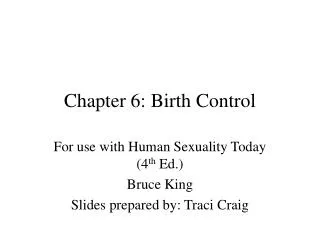
Chapter 6: Birth Control
Chapter 6: Birth Control. For use with Human Sexuality Today (4 th Ed.) Bruce King Slides prepared by: Traci Craig. Chapter Overview. Teen Pregnancy in the US Worldwide need for contraception Myths and Ineffective Methods Fertility Awareness Methods Barrier Methods IUD Hormonal Methods
1.31k views • 53 slides
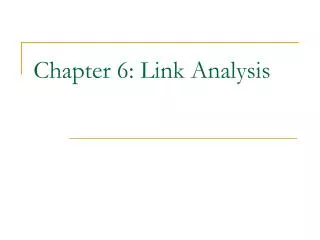
Chapter 6: Link Analysis
Chapter 6: Link Analysis. Road map. Introduction Social network analysis Co-citation and bibliographic coupling PageRank HITS Summary. Introduction. Early search engines mainly compare content similarity of the query and the indexed pages. I.e.,
1.42k views • 73 slides

Chapter 6 Birth Control
Chapter 6 Birth Control. For use with the text, Human Sexuality Today , 5 th edition. Bruce M. King Slides by Callista Lee. Unwanted and unplanned pregnancies. Birth control – methods of preventing unwanted births; this term includes “contraception.”
606 views • 39 slides
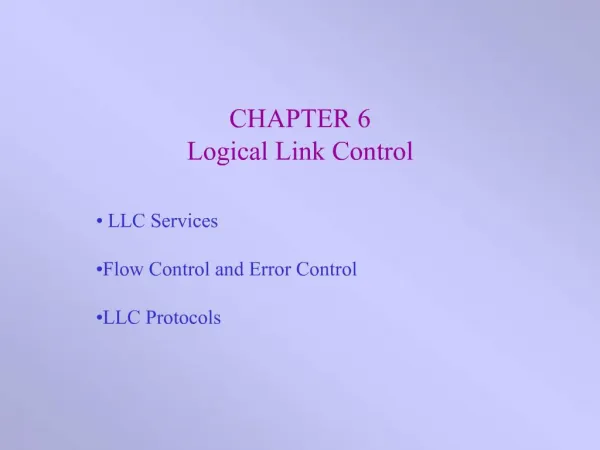
CHAPTER 6 Logical Link Control
Chapter 6. Networking for Manufacturing. 6-2. 6.1 LLC SERVICES. three forms of service-unacknowledged connectionless service-connection-mode service-acknowledged connectionless serviceLLC service primitives-request-indication-response-confirm. Chapter 6. Networking for Manufacturing.
1.38k views • 32 slides
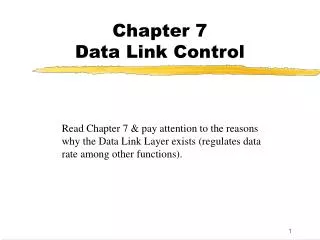
Chapter 7 Data Link Control
Chapter 7 Data Link Control. Read Chapter 7 & pay attention to the reasons why the Data Link Layer exists (regulates data rate among other functions). Source node. Destination node. Application. Application. Presentation. Presentation. Session. Session. Intermediate node. transport.
791 views • 64 slides
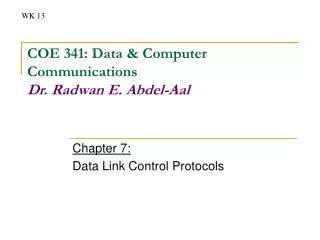
Chapter 7: Data Link Control Protocols
WK 13. COE 341: Data & Computer Communications Dr. Radwan E. Abdel-Aal. Chapter 7: Data Link Control Protocols. Where are we:. Chapter 7: Data Link: Flow and Error control. Data Link. Chapter 8: Improved utilization: Multiplexing. Physical Layer.
1.07k views • 80 slides
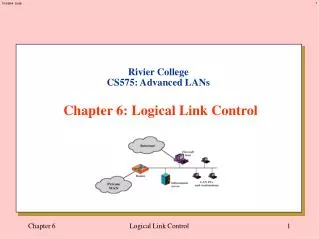
Rivier College CS575: Advanced LANs Chapter 6: Logical Link Control
Rivier College CS575: Advanced LANs Chapter 6: Logical Link Control. IEEE 802 Protocol Layers Compared to OSI Model. Logical Link Control Services. Unacknowledged connectionless service Connection-mode service Acknowledged connectionless service. Logical Link Control (LLC) Primitives.
444 views • 20 slides
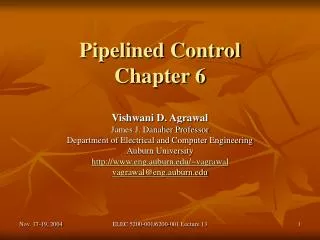
Pipelined Control Chapter 6
Pipelined Control Chapter 6. Vishwani D. Agrawal James J. Danaher Professor Department of Electrical and Computer Engineering Auburn University http://www.eng.auburn.edu/~vagrawal vagrawal@eng.auburn.edu. Pipelined Datapath (without Jump). IF/ID. ID/EX. EX/MEM. MEM/WB. 4. 1 mux 0.
503 views • 34 slides
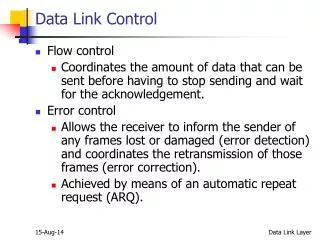
Data Link Control
Data Link Control. Flow control Coordinates the amount of data that can be sent before having to stop sending and wait for the acknowledgement. Error control
510 views • 24 slides

Data Link Control
Data Link Control. For effective data communication. Frame synchronization Flow control Error control Addressing Control and data on same link Link Management. Flow Control. Necessary when data is being sent faster than it can be processed by receiver
351 views • 14 slides

Data Link Control
Data Link Control. Line Discipline Flow Control Error Control. Figure 10-1. Functions of Data Link Layer. Figure 10-2. Figure 10-3. Figure 10-4. ENQ/ACK. Figure 10-5. ENQ/ACK. Figure 10-6. Multipoint Discipline. Figure 10-7. Select. Figure 10-8. Poll. Figure 10-9.
414 views • 26 slides

Data Link Control
Data Link Control. Physical layer is only responsible for data transmission Data link control is responsible for converting transmission to communication Line Discipline: Who should send now? Flow Control: How much data may be sent?
810 views • 22 slides
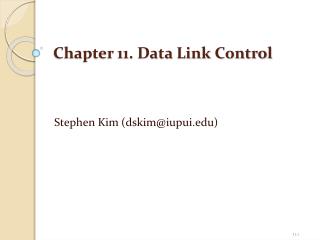
Chapter 11. Data Link Control
Chapter 11. Data Link Control. Stephen Kim (dskim@iupui.edu). FRAMING.
1.44k views • 101 slides

Data Link Control
General principles. Data Link Control. Coordinating between two end-systems across a Link to send/receive data correctly Who should send and when – Medium Access Coordinating sending and receiving – Line Discipline – involves Link establishment etc
455 views • 15 slides

Data Link Control
Data Link Control. Line Discipline Flow Control Error Control. The McGraw-Hill Companies, Inc., 1998. WCB/McGraw-Hill. Figure 10-2. The McGraw-Hill Companies, Inc., 1998. WCB/McGraw-Hill. Figure 10-3. Line Disipline. There may be many devices trying to send the data .
603 views • 34 slides
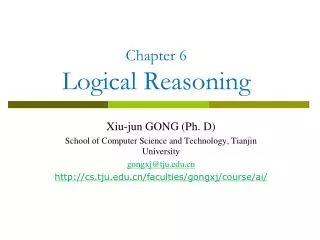
Chapter 6 Logical Reasoning
Chapter 6 Logical Reasoning. Xiu-jun GONG (Ph. D) School of Computer Science and Technology, Tianjin University gongxj@tju.edu.cn http:// cs.tju.edu.cn/faculties/gongxj/course/ai /. Outline. Intro to logic reasoning Preparation for resolution Stand form clauses (9 steps)
761 views • 38 slides

Chapter 7: Data Link Control Protocols
COE 341: Data & Computer Communications (T061) Dr. Radwan E. Abdel-Aal. Chapter 7: Data Link Control Protocols. Where are we:. Chapter 7: Data Link: Flow and Error control. Data Link. Chapter 8: Improved utilization: Multiplexing. Physical Layer.
1.41k views • 86 slides

Chapter 11 Data Link Control
Chapter 11 Data Link Control. Framing Flow and Error Control Protocols Noiseless Channels Noisy Channels HDLC Point-to-Point Protocol. Framing. Data link layer needs to pack bits into frames, so that each frame is distinguishable from another
673 views • 53 slides

Data Link Control Chapter 7
Data Link Control Chapter 7. Placement of the Data Link Protocol. Functions of Data Link Control. Frame synchronization Flow control Error control Addressing Control and data on same link Link management
836 views • 49 slides
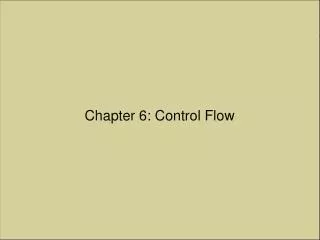
Chapter 6: Control Flow
Chapter 6: Control Flow. Chapter 6: Control Flow. 6.1 Expression Evaluation 6.2 Structured and Unstructured Flow 6.3 Sequencing 6.4 Selection 6.5 Iteration 6.6 Recursion 6.7 Non-determinacy. Control Flow. Control flow refers to the order in which a program executes
1.03k views • 51 slides
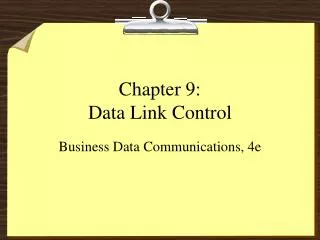
Chapter 9: Data Link Control
Chapter 9: Data Link Control. Business Data Communications, 4e. Flow Control. Necessary when data is being sent faster than it can be processed by receiver Computer to printer is typical setting Can also be from computer to computer, when a processing program is limited in capacity.
218 views • 14 slides

Chapter 6:: Control Flow
Chapter 6:: Control Flow. Programming Language Pragmatics. Michael L. Scott. Control Flow. Basic paradigms for control flow: Sequencing Selection Iteration Subroutines, recursion (and related control abstractions, e.g. iterators) Nondeterminacy – ordering unspecified
481 views • 22 slides
























